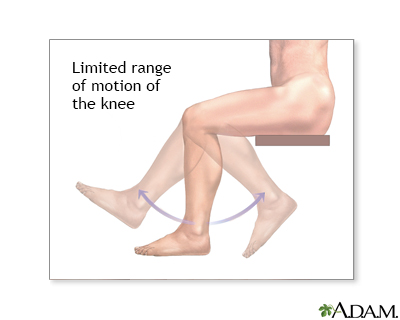Pregnancy SmartSiteTM
DefinitionLimited range of motion is a term meaning that a joint or body part cannot move through its normal range of motion. ConsiderationsMotion may be limited because of a problem within the joint, swelling of tissue around the joint, stiffness of the ligaments and muscles, or pain. CausesA sudden loss of range of motion may be due to:
Loss of motion may occur if you damage the bones within a joint. This may happen if you have:
Brain, nerve, or muscle disorders can damage the nerves, tendons, and muscles, and can cause loss of motion. Some of these disorders include:
Home CareYour health care provider may suggest exercises to increase muscle strength and flexibility. When to Contact a Medical ProfessionalMake an appointment with your provider if you have difficulty moving or extending a joint. What to Expect at Your Office VisitThe provider will examine you and ask about your medical history and symptoms. You may need joint x-rays and spine x-rays. Laboratory tests may be done. Physical therapy may be recommended. ReferencesDebski RE, Patel NK, Shearn JT. Basic concepts in biomechanics. In: Miller MD, Thompson SR, eds. DeLee, Drez, & Miller's Orthopaedic Sports Medicine. 5th ed. Philadelphia, PA: Elsevier; 2020:chap 2. Magee DJ, Manske RC. Primary care assessment. Magee DJ, Manske RC, eds. Orthopedic Physical Assessment. 7th ed. St Louis, MO: Elsevier; 2021:chap 17. | |
| |
Review Date: 9/20/2022 Reviewed By: C. Benjamin Ma, MD, Professor, Chief, Sports Medicine and Shoulder Service, UCSF Department of Orthopaedic Surgery, San Francisco, CA. Also reviewed by David C. Dugdale, MD, Medical Director, Brenda Conaway, Editorial Director, and the A.D.A.M. Editorial team. The information provided herein should not be used during any medical emergency or for the diagnosis or treatment of any medical condition. A licensed medical professional should be consulted for diagnosis and treatment of any and all medical conditions. Links to other sites are provided for information only -- they do not constitute endorsements of those other sites. No warranty of any kind, either expressed or implied, is made as to the accuracy, reliability, timeliness, or correctness of any translations made by a third-party service of the information provided herein into any other language. © 1997- A.D.A.M., a business unit of Ebix, Inc. Any duplication or distribution of the information contained herein is strictly prohibited. | |

 The structure of a...
The structure of a... Limited range of m...
Limited range of m...
